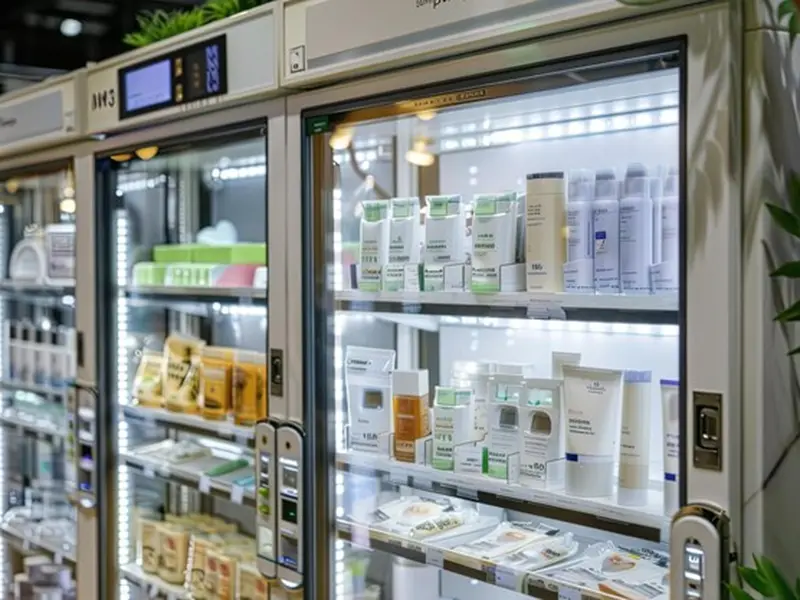3 International Certifications Required for Medical Heat Exchangers

Medical heat exchangers play a vital role in ensuring precise temperature control for medical devices. Their importance is underscored by a market expected to grow from USD 1.2 billion in 2023 to USD 2.1 billion by 2032, driven by advancements in healthcare infrastructure and the rising demand for efficient thermal management. Devices like the copper fin heat exchanger exemplify this innovation, offering reliable solutions for critical applications.
Key Takeaways
- ISO 13485 makes sure medical heat exchangers are made safely. It improves product safety and dependability.
- AHRI Performance Certification checks how well heat exchangers work. This builds trust and honesty in performance promises.
- EAC Certification ensures products meet health and safety rules in the Eurasian Economic Union. It helps manufacturers sell in that market.
ISO 13485: Quality Management System for Medical Devices

Overview of ISO 13485
ISO 13485 is an internationally recognized standard for quality management systems (QMS) tailored to the medical device industry. It outlines specific requirements to ensure the design, production, and distribution of safe and effective medical devices. First published in 1996, the standard has undergone updates, with the latest version released in 2016. This update introduced clearer definitions and stricter guidelines for compliance. For manufacturers like Senjun, adhering to ISO 13485 means establishing a robust QMS that meets global regulatory expectations.
The standard emphasizes documentation, risk management, and traceability throughout the product lifecycle. For instance, Clause 7.3 requires detailed records for design controls, while Clause 8.2.5 mandates monitoring and measuring processes to maintain quality. These measures ensure that products like copper fin heat exchangers meet stringent safety and performance benchmarks.
Purpose of ISO 13485 in Medical Heat Exchangers
Medical heat exchangers, including copper fin heat exchangers, play a critical role in maintaining precise temperature control in devices like medical refrigerators and dehumidifiers. ISO 13485 ensures that these components are manufactured under strict quality controls, minimizing risks associated with defective products.
By implementing ISO 13485, manufacturers can streamline operations, enhance product reliability, and meet regulatory requirements. This certification also builds trust with healthcare providers, who rely on certified products to ensure patient safety. At Senjun, we prioritize ISO 13485 compliance to deliver high-quality heat exchangers that meet the demands of the medical industry.
How ISO 13485 Ensures Compliance and Safety
ISO 13485 enhances compliance and safety through rigorous quality control measures. Regular audits assess the effectiveness of a manufacturer’s QMS, ensuring adherence to regulatory standards. For example, auditors evaluate documentation for design controls, production validation, and post-market surveillance. These assessments identify operational risks, enabling manufacturers to implement corrective actions promptly.
Additionally, ISO 13485 reduces liability risks by ensuring that products meet safety standards. For medical heat exchangers, this means fewer recalls and improved performance. At Senjun, we leverage ISO 13485 to maintain high safety standards, ensuring our copper fin heat exchangers consistently deliver reliable results.
AHRI Performance Certification: Ensuring Heat Exchanger Efficiency
What is AHRI Performance Certification?
The Air-Conditioning, Heating, and Refrigeration Institute (AHRI) Performance Certification is a globally recognized program that verifies the performance of HVACR products. This certification ensures that products, including heat exchangers, meet the performance claims made by manufacturers. At Senjun, we understand the importance of this certification in building trust with our clients. AHRI’s rigorous testing process involves independent laboratories that evaluate products against published specifications. This ensures compliance with industry standards like ASHRAE and LEED, which promote energy efficiency and sustainability.
Importance of AHRI Certification for Medical Heat Exchangers
Medical heat exchangers, such as copper fin heat exchangers, require precise performance to maintain temperature control in critical applications. AHRI certification provides peace of mind to manufacturers, healthcare providers, and end-users by verifying that these devices meet strict efficiency standards. It also eliminates discrepancies in performance claims, fostering transparency and integrity within the industry. For instance, AHRI-certified products enable fair comparisons of thermal performance, ensuring that healthcare facilities invest in reliable and efficient equipment. At Senjun, we prioritize AHRI certification to deliver high-quality solutions for medical applications.
How AHRI Certification Ensures Performance Standards
AHRI certification ensures performance standards through independent testing and third-party verification. Products undergo continuous evaluation to confirm that they meet manufacturer ratings. This process guarantees compliance with technical standards and enhances confidence in product reliability. The certification also emphasizes energy efficiency, reducing operating costs and encouraging innovation.
| Benefit | Description |
|---|---|
| Energy Efficiency | Lowers energy consumption and reduces lifetime operating costs. |
| Performance Comparison | Enables fair comparisons of thermal performance and price/performance ratio. |
| Confidence | Provides peace of mind for suppliers, contractors, and end-users. |
| Industry Integrity | Eliminates cheating from thermal performance, enhancing trust in the industry. |
At Senjun, we leverage AHRI certification to ensure that our copper fin heat exchangers consistently meet the highest standards of efficiency and reliability.
EAC Certification: Compliance in the Eurasian Economic Union
What is EAC Certification?
EAC Certification is a mandatory compliance standard for products traded within the Eurasian Economic Union (EAEU). It ensures that products meet stringent health, safety, and environmental regulations. The certification process includes obtaining either a Certificate of Compliance for domestic products or an EAC Declaration for industrial use. This regulatory framework reflects the EAEU’s commitment to maintaining high standards across its member countries.
The EAEU market spans five countries and nearly 200,000 consumers, making compliance essential for manufacturers seeking market access. At Senjun, we recognize the importance of EAC Certification in ensuring our copper fin heat exchangers meet these rigorous standards. Non-compliance can result in fines or confiscation of products, emphasizing the need for adherence to regulations like Safety (TR 004), EMC (TR 020), and EAEU RoHS (TR 037).
Relevance of EAC Certification for Medical Heat Exchangers
EAC Certification plays a crucial role in the medical industry, where precision and reliability are paramount. Medical heat exchangers, including copper fin heat exchangers, must comply with EAC standards to ensure safe and efficient operation in critical applications. This certification guarantees that products meet the EAEU’s strict requirements for health and safety, fostering trust among healthcare providers and patients.
For manufacturers like Senjun, EAC Certification not only facilitates market entry but also enhances product credibility. It assures clients that our heat exchangers are designed and produced under stringent quality controls. This compliance builds confidence in our ability to deliver reliable solutions for medical applications.
Steps to Achieve EAC Certification
Achieving EAC Certification involves a structured process that ensures compliance with EAEU regulations. Here’s how manufacturers can obtain certification:
- Approve the certification scheme.
- Select product samples for testing based on established principles.
- Conduct laboratory tests or other checks, depending on the product type.
- Register laboratory test reports.
- Review the producer’s Quality Management System.
- Decide whether to issue the EAC certificate of conformity based on the collected data.
- Issue the certificate and enter it into the official register.
At Senjun, we follow these steps meticulously to ensure our copper fin heat exchangers meet EAC standards. This process not only validates product quality but also reinforces our commitment to delivering safe and efficient solutions for the medical industry.
ISO 9001:2015: Quality Management for Consistent Production
Overview of ISO 9001:2015
ISO 9001:2015 is a globally recognized standard for quality management systems (QMS). It provides a framework for organizations to ensure consistent product quality and operational efficiency. This standard emphasizes a process-based approach, integrating risk management and customer satisfaction into every stage of production. At Senjun, we align our strategic objectives with ISO 9001:2015 to maintain high standards in manufacturing medical heat exchangers, including the Copper Fin Heat Exchanger.
The historical context of ISO 9001:2015 highlights its adaptability to dynamic environments. For example:
- It reflects changes in global manufacturing practices.
- It ensures organizations meet customer expectations.
- It serves as a foundation for Total Quality Management (TQM).
| Aspect | Description |
|---|---|
| Context of the Organization | Focuses on internal and external factors influencing the QMS. |
| Strategic Objectives | Aligns QMS with organizational goals for effective management. |
Importance of ISO 9001:2015 for Medical Heat Exchangers
ISO 9001:2015 certification is crucial for ensuring the reliability of medical heat exchangers. A study published in Heliyon revealed that companies with this certification experienced significant improvements in operational performance. This standard fosters a customer-centric approach, aligning production processes with healthcare providers' needs.
For manufacturers like us at Senjun, ISO 9001:2015 enhances market access and builds trust with clients. It ensures that our Copper Fin Heat Exchangers consistently meet stringent quality requirements. Leadership involvement and staff competency play pivotal roles in implementing this standard effectively, fostering a culture of continuous improvement.
How ISO 9001:2015 Ensures Quality and Safety
ISO 9001:2015 ensures quality and safety through rigorous process controls and compliance measures. For instance, KRN Heat Exchanger and Refrigeration Limited employs hydro-testing and pressure testing to meet safety standards. Similarly, we at Senjun adopt advanced testing protocols to ensure our products meet regulatory and customer expectations.
| Evidence Type | Description |
|---|---|
| Hydro-testing | Ensures structural integrity and leak-free performance. |
| Pressure Testing | Verifies units can withstand up to 300 PSI. |
| Cleanliness Verification | Exceeds API 614 standards for safety and quality. |
Longitudinal studies also highlight the enduring benefits of ISO 9001:2015. Manufacturing companies certified under this standard maintain compliance for over six years, demonstrating its role in sustaining product integrity. By adhering to ISO 9001:2015, we ensure our Copper Fin Heat Exchangers deliver consistent performance and safety.
International certifications ensure the safety, quality, and compliance of medical heat exchangers. These standards, such as ISO 13485 and AHRI Performance Certification, enhance product reliability and build trust with healthcare providers. For example:
- Certifications improve product safety and regulatory compliance.
- They enable global market access and foster customer confidence.
- Risk management processes enhance patient safety and operational efficiency.
At Senjun, we prioritize these certifications to deliver reliable solutions like the Copper Fin Heat Exchanger. This commitment reflects our dedication to quality and patient safety, ensuring healthcare providers can trust our products.
FAQ
What are the benefits of obtaining international certifications for medical heat exchangers?
International certifications ensure product safety, enhance reliability, and build trust with healthcare providers. They also facilitate global market access and compliance with regulatory standards.
How does Senjun ensure compliance with these certifications?
We follow strict quality management protocols, conduct rigorous testing, and adhere to global standards like ISO 13485, AHRI, and EAC to deliver reliable and efficient products.
Why is ISO 9001:2015 important for medical heat exchangers?
ISO 9001:2015 ensures consistent product quality through process controls and risk management. It aligns production with customer needs, enhancing reliability and operational efficiency.
💡 Tip: Always verify a product's certifications before purchasing to ensure compliance with industry standards.


















